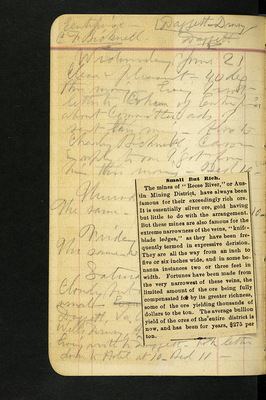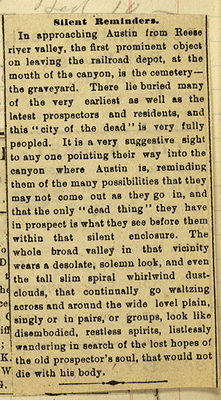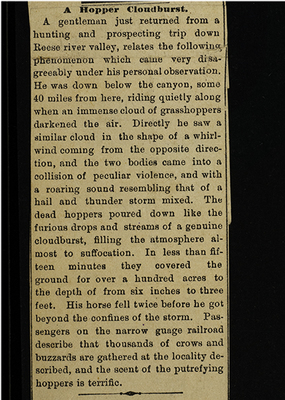Pages
1
Small But Rich.
The mines of "Reese River," or Austin Mining District, have always been famous for their exceedingly rich ore, gold having but little to do with the arrangement. But these mines are also famous for the extreme narrowness of the veins, "knife-blade ledges," as they have been frequently termed in expressive derision. They are all the way from an inch to five or six inches wide, and in some bonanza instances two or three feet in width. Fortunes have been made from the very narrowest of these veins, the limited amount of the ore being fully compensated for by its greater richness, some of the ore yielding thousands of dollars to the ton. The average bullion yield of the ores of the entire district is now and has been for years, $275 per ton.
2
DAILY REVEILLE
AUSTIN, NEVADA
Tuesday..........June 27, 1882
YANKEE BLADE.
Present Mining Operations–Rich Ore–Prospecting and Prospects.
Last Sunday a REVEILLE representative, in company with W. E. Ford, one of the pioneers of that section, took a buckboard tur of observation out into the old Yankee Blade Mining District, some four or five miles to the northward of Austin. The road past Clifton and skirting along Reese river valley, crossing the mouths of Emigrant and Telegraph canyons, and up Yankee Blade Canyon, is in very fair condition, allowing of good traveling progress.
YANKEE BLADE
Used to be a camp of considerable importance in the early booming days, with hundreds of fortune-seekers busily digging holes all over the face of the country, in all directions, searching after the small but rich ledges. Now there are less than a dozen little cabins to be seen, scattered around the hillsides, within the space of a mile, and only about forty men are working the few paying mines or mining prospects. The ore veins are all small, like those of Austin, and if not a continuation of the same, are of the same style, being from an inch or two to about a foot in width. The ore, also, is of the same general character, showing less ruby, but more of the black antimonial silver, and more native silver, with little or no gold. The ore veins run the four cardinal points of the compass. The Yankee Blade vein runs north and south, with a dup to the west. It is about a foot wide and has yielded a goodly amount of bullion in its time, but is not being worked at present. It belongs to the Manhattan Company. The Virginia, owned by the Jones brothers is about two feet wide dipping west. They are working it, but shipping no ore. It also runs north and south. All the other ledges are of the few inch kind, and run east and west dipping north. These ledges are all incased in granite or syenite, with some slate in the upper portion of the canyon. Considerable water is met with in sinking, therefore few of the mines or prospectings have been carried to considerable depth. Patrick Sinnott is engaged in developing the Silver Wave, and the New Ross, both old but at present promising locations, on the north side of the canyon. Baker, Holmes & Co. are also developing the Maggie, an old favorite, cleaning out the old incline, which is 200 feet deep, and preparing to make their fortunes. Neither of these last are yielding any ore at present but are expected to after awhile.
PRODUCING MINES.
Ford & Johnson are working the Argenta. It is one of the east and west ledges, and is followed by an incline about 125 feet deep, with whim hoisting works. The vein is about six inches wide, but occasionally pinches to about nothing. The ore, however, is very rich, averaging not far from $500 to the ton. They shipped two tons to the Manhattan mill on Sunday and are industriously rooting about after more.
The Patriot mine lies have a mile or so above in the canyon, and shows the only steam hoisting works, as well as the most active and extensive mining operations in Yankee Blade. It was leased fourteen months ago from the owners by Melville Curtis, Daniel Farrell and Patrick Kelly, since which time they have done a vast amount of work and developed a good paying mine. They work by means of an incline, following the ledge down 420 feet on the slope. A very neat and smooth-working engine of 15 horse power and the three feet eight inches stroke does all the hoisting, and also runs the pump 21 hours out of 24 to keep the water down. On the 400 foot level they have drifted 300 feet west, and are still at it. On the 300 foot level, where they get the most of their ore, they have drifted 500 feet west and 90 feet east. The ore worked thus far at the Manhattan mill has averaged $450 to the ton, and they are still shipping more occasionally.
Walker's mine, as it is generally called, is the old Morris & Cable location. R. L. Walker, present proprietor, bought it a couple of years ago. It is situated in the ridge between Yankee Blade and New York canyons, and within the Yankee Blade District. The ledge is from six inches to a foot in width, and the main adit to this mine is a tunnel from New York canyon 1,300 feet in length, 200 feet of which follows the ledge itself. Seven hundred feet in from the mouth of the tunnel is an incline winze, 225 feet deep, following the ledge, and from which the ore is now being taken. The smoke-stack of this engine is 300 feet long, and is carried up through an upraise or incline to the surface, on the Yankee Blade side of the mountain. The first-class ore from this mine is exceedingly rich, showing much native silver as well as the richest of sulphurets and antimonial silver. Two tons of this, ready for shipment to the Manhattan mill, were estimated to be worth $1,500 or $2.000 per ton. Ten tons of second=class ore worth $500 per ton were also ready for shipment, and 23 tons of the same sort were shipped a few days ago.
ETCETERA.
The Chase and True Blue locations, on New York canyon, show a large amount of good work done, and much money expended, but like Breen's mine at the mouth of Yankee Blade canyon, and scores of others which space will not allow mention of, all are abandoned, or not being worked at present. The ruins of sundry mills built in former and more promising times are also silent reminders of the early excitement, lost dollars and buried hopes.
3
Silent Reminders.
In approaching Austin from Reese river valley, the first prominent object on leaving the railroad depot, at the mouth of the canyon, is the cemetery–the graveyard. There lie buried many of the very earliest as well as the latest prospectors and residents, and this "city of the dead" is very fully peopled. It is a very suggestive sight to any one pointing their way into the canyon where Austin is, reminding them of the many possibilities that they may not come out as they go in, and that the only "dead thing" they have in prospect is what they see before them within that silent enclosure. The whole broad valley in that vicinity wears a desolate, solemn look, and even the tall slim spiral whirlwind dust-clouds, that continually go waltzing across and around the wide level plain, singly or in pairs, or groups, look like disembodied, restless spirits, listlessly wandering in search of the lost hopes of the old Prospector's soul, that would not die with his body.
4
DAILY REVEILLE
AUSTIN, NEVADA
Thursday..........July 10,1864
SOME OLD FISH
At the rear end of Henry Glahn's United States Bakery, across the street from the REVEILLE office, is a good sized tunnel, an excavation about 30 feet in length, in the solid granite, It was made in the early days and has been in use ever since as a cellar, forming a very nice cool vault. In excavating this cellar or tunnel, near the back end or face, a fine spring of pure cold water was found oozing up through the rock floor, and quite a stream still flows from it. This spring was valuable in those days, when water was scarce, and supplied not only the bakery but some of the neighbors. A hole about three feet long, two wide, and a foot deep, was dug in the rock for the spring, which was kept covered with planks.
Early in 1867 the proprietor one day procured half a dozen small fish from Reese river, alive, and put them in this spring. They were of the red streaked sucker variety, six or seven inches in length, and took very kindly to their quiet, dark, little prison. This was fifteen years ago. Since then one or two have died, others were given away, and there are now only two left. None of them ever grew any larger, the two remaining still being about six or seven inches in length. They have never been fed but have subsisted entirely on the clear running water, there being no flies or any other insect in that dark, closely shut spring. They have never seen sunlight and scarcely daylight for fifteen years, there being rarely ever any occasion to remove the cover of the spring, except to look at the fish, and the spring never requires cleaning out. Three years ago a new wooden boxing was put in the spring, since which time it has not been disturbed.
How old the fish were when taken from the river could not, of course, be known, but they had evidently attained their full growth. They look faded and old enough now, probably owing to the total darkness and seclusion in which they live, but they are as alive as ever, and bid fair to stay till the mines are worked out, if they meet with no accident.
5
A Hopper Cloudburst.
A gentleman just returned from a hunting and prospecting trip down Reese river valley, relates the following phenomenon which came very disagreeably under his personal observation. He was down below the canyon, some 40 miles from here, riding quietly along when an immense cloud of grasshoppers darkened the air. Directly he saw a similar cloud in the shape of a whirlwind coming from the opposite direction, and the two bodies came into a collision of peculiar violence, and with a roaring sound resembling that of a hail and thunder storm mixed. The dead hoppers poured down like the furious drops and streams of a genuine cloudburst, filling the atmosphere almost to suffocation. In less than fifteen minutes they covered the ground for over a hundred acres to the depth of from six inches to three feet. His horse fell twice before he got beyond the confines of the storm. Passengers on the narrow gauge railroad describe that thousands of crows and buzzards are gathered at the locality described, and the scent of the putrefying hoppers is terrific.






